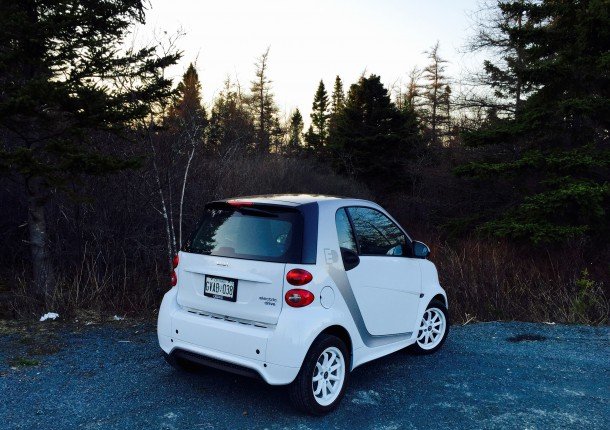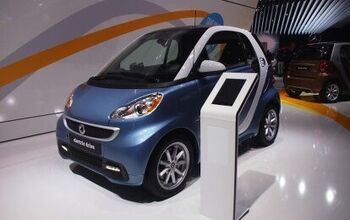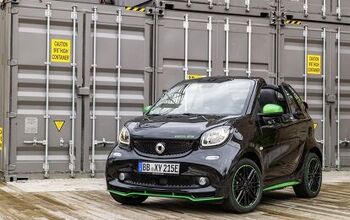2015 Smart Fortwo Electric Drive Review
I like Smarts.
It’s not a guilty pleasure, for I am not ashamed. It is a bizarre pleasure, however, lacking consistency and believability.
I’m a true blue car enthusiast with a love of V8 rumble, turbocharged torque, supercharged sizzle, manual shifters, and performance wagons. And yet, I can’t help myself: I like the way the Smart Fortwo steers. I’ve adapted to the way it wants to be shifted. I love the feeling of interior airiness. And I periodically enjoy well and truly pushing a car to its limits just to make proper forward progress. Approaching the limits in those performance cars I love? That’s a recipe for jail time.
As much as I like Smart Fortwos, my wife likes them a whole lot more. So in 2009, after our old Topaz, a new Civic, and a Santa Fe company car, she leased a second-generation model during a week of ridiculous Mercedes-Benz discounting that made the Fortwo significantly more affordable than any other new vehicle. The W451 wasn’t as efficient as the diesel model with which she fell in love in 2004, but it was thousands of dollars less expensive, much roomier inside, built better, and – in concert with the severe price cut – free to maintain. (The diesel 450 most certainly was not.)
She rarely drove the car outside the downtown core where we lived. Chief among the car’s annoyances wasn’t the transmission – the car really does force you into an unconventional acclimatization – but rather the difficulty of holding steady at the posted speed limit of 110 km/h. Fortwos prefer to settle in at an easy 130, a speed at which highway fuel consumption sharply increased. Cargo capacity and flexibility never ceased to amaze. The observed mileage far exceeded the Smart’s official ratings.
RATIONALIZING
No, not in our province, not in our lives, not even as a second car. A $30,000 two-seater with no performance credentials to speak of, no available tax rebates, lengthy charging times, and a dearth of ordinary creature comforts isn’t a recipe for success. This whole “compliance” electric car production works in a buyer’s favor with the right lease deal, in the proper U.S. jurisdiction, if they plan to operate a different primary car, and, of course, if they like Smarts.
DRIVING
More unusual is the stark difference between the way the Fortwo Electric Drive makes its way down the road in comparison with a normal second-generation Fortwo. The electric version is 16% heavier, and with the added weight settled low in the structure, the Electric Drive rides more sedately. But the steering is very heavy and rather unwilling to move far off centre.
Throttle calibration is nicely weighted, and the initial surge of torque is genuinely pleasing, as in so many electric cars. With no shifts to be completed, the Fortwo ED simply continues to build speed in a strange manner, so very unlike the normal Fortwo which, while in possession of passing power at highway speed, doesn’t exactly race down an on-ramp. The Electric Drive, on the other hand, is out of breath at higher speeds.
Brake feel is dreadful in this electric car, but the regen modes (through which you can cycle using the paddle shifters) can be so effective that one-pedal driving becomes commonplace. One-pedal driving is the best.
From a handling perspective, the weight which improves ride quality greatly reduces the feeling of agility that makes the regular Fortwo such a blast in the city. As a result, much of my reasoning for labelling the Fortwo as “fun” is lost, because this car isn’t nearly as enjoyable to hustle around town as the gas car.
RULING
A Fortwo Electric Drive and a normal Fortwo share another trait. They are most definitely acquired tastes, even for the previously indoctrinated. On day one, the Fortwo Electric Drive comes across as weird and mildly humorous. A day later, it’s simply weird. On day three, you’ve surely encountered an experience that causes it to be unfortunately weird and you’re not especially humored. Day four brings your mind around to weird but decently useful. On days five and six you’ve learned to drive the Fortwo as it wants to be driven, making it both weird and moderately fun.
By week’s end, it’s weird and likeable. But not sufficiently likeable, not with such limited range or at such a lofty price. Similarly equipped gas-fired Fortwos are at least $10,000 less, ride worse but handle better, accelerate slower but cruise more effectively, and are not limited by a charging cycle.
WAITING
The 2016 Fortwo will be slightly larger but still blissfully small. While the size causes such consternation in legions of buyers worried for their personal well-being, I always believed the Fortwo’s tidy dimensions produced odds which were ever in my favor. After all, there’s a lot less of me to hit.
Timothy Cain is the founder of GoodCarBadCar.net, which obsesses over the free and frequent publication of U.S. and Canadian auto sales figures. Follow on Twitter @goodcarbadcar and on Facebook.
More by Timothy Cain
Latest Car Reviews
Read moreLatest Product Reviews
Read moreRecent Comments
- UnoGeeks Great information. Unogeeks is the top SAP ABAP Training Institute, which provides the best SAP ABAP Training
- ToolGuy This thing here is interesting.For example, I can select "Historical" and "EV stock" and "Cars" and "USA" and see how many BEVs and PHEVs were on U.S. roads from 2010 to 2023."EV stock share" is also interesting. Or perhaps you prefer "EV sales share".If you are in the U.S., whatever you do, do not select "World" in the 'Region' dropdown. It might blow your small insular mind. 😉
- ToolGuy This podcast was pretty interesting. I listened to it this morning, and now I am commenting. Listened to the podcast, now commenting on the podcast. See how this works? LOL.
- VoGhost If you want this to succeed, enlarge the battery and make the vehicle in Spartanburg so you buyers get the $7,500 discount.
- Jeff Look at the the 65 and 66 Pontiacs some of the most beautiful and well made Pontiacs. 66 Olds Toronado and 67 Cadillac Eldorado were beautiful as well. Mercury had some really nice looking cars during the 60s as well. The 69 thru 72 Grand Prix were nice along with the first generation of Monte Carlo 70 thru 72. Midsize GM cars were nice as well.The 69s were still good but the cheapening started in 68. Even the 70s GMs were good but fit and finish took a dive especially the interiors with more plastics and more shared interiors.







































Comments
Join the conversation
I got a 2013 Smart ED in January 2014 as an experiment to see if I could live with an EV. At the time they were offering nothing down, $129/month for 36 months. With our state tax incentives in Georgia for ZEV, that makes it almost free. 20% off MSRP up to $5k tax credit. We had 3 other Mercedes and I rationalized it by saying that it is technically designed by Mercedes and matched our other three silver cars. In a short amount of time, I went from my regular commuter, a 2008 ML63 AMG to driving the Smart everyday. It makes sense in heavy traffic and tiny parking garages. On days of heavy traffic I use to get an indicated 7 mpg in my ML, where the Smart would get about 3.2 miles/kWh. My daily commute costs went from $7-8/day to $0.75. I liked commuting on backroads anyways so speeds never really got higher than about 55mph. The range proved not a problem in 6 months. It's great to be able to drive around and not have to worry about how much gas/$$$ you are wasting. Then one day in April 2014, I test drove the BMW i3 and a couple months later when they were released, ended up trading my ML63. The i3 is so much better than any other EV, even the Tesla for the price. I gave my father our E500 and we got another i3 for my partner's commute. Our second i3 is an even better deal than the Smart. I paid net about $1,500 for two years of driving or about $62/month after tax incentives and discount on left over 2014 i3. Not to mention we save over $300/month in gas for my ML and about $250/month for the E500.
I had a diesel fortwo for 9 years and loved it, but the maintenance was starting to get expensive, and at 180,000 km, was nearing the stage of everything having to be replaced a second time. When i got wind of the crazy lease deals last summer, i jumped on an ED, and i'm glad i did. I loved my diesel, but i'm over the moon in love with the electric drive. It suits 90% of the driving i do, and it's a BLAST to drive. The whine of the electric motor when you stomp on the "go" pedal is as addictive as the roar of a big internal combustion engine. And the torque! In Ontario, it was a sweetheart deal on the lease. Since Mercedes-Benz Financial is technically the "owner", they applied for the rebate on the lessee's behalf, and it essentially went toward the down payment, resulting in $100/month payments. Brilliant. What i made on the sale of my original diesel went toward getting a Level 2 charger installed.